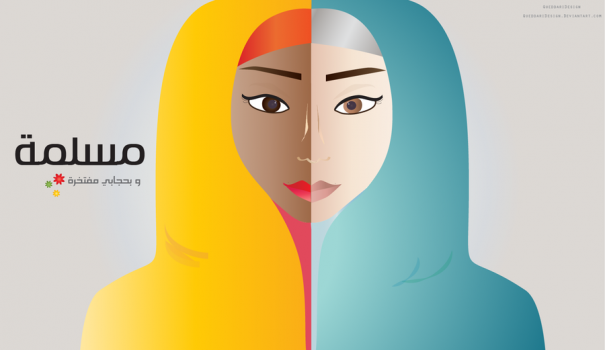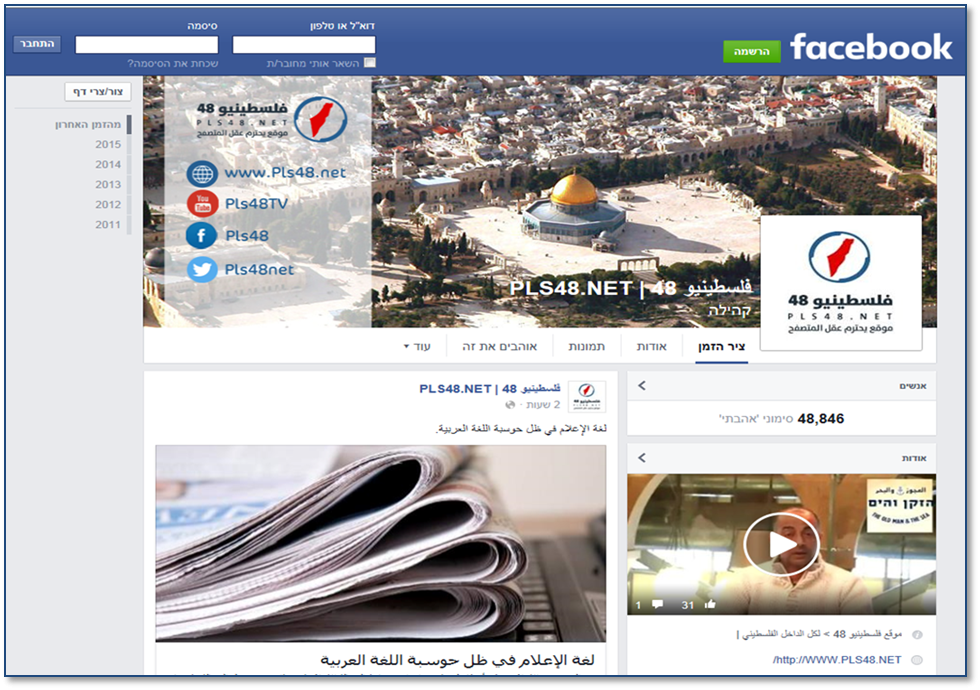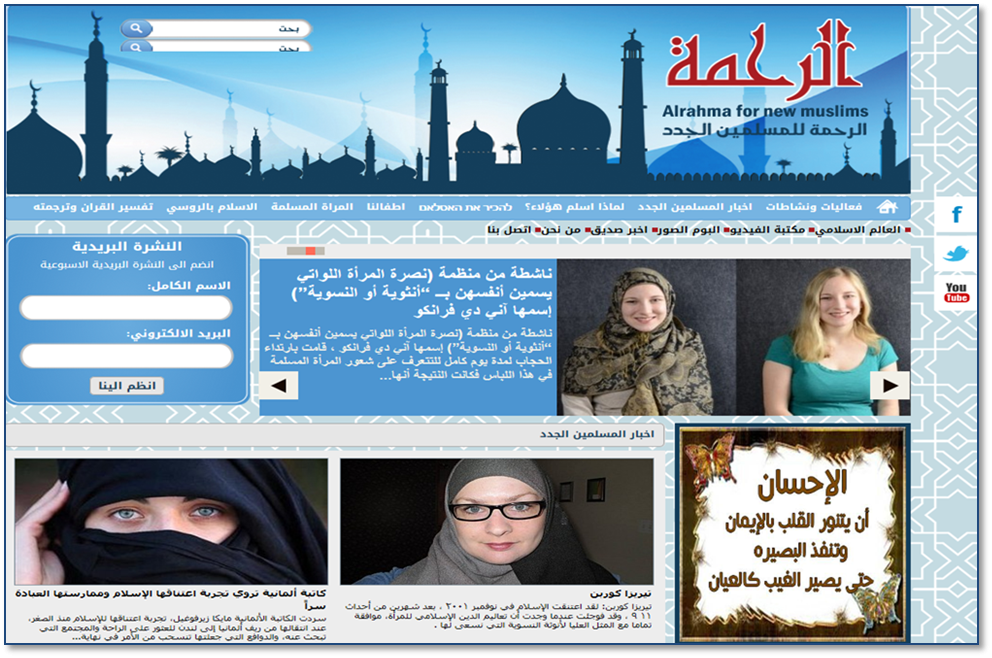
Image from the website of the Northern Branch of the Islamic Movement in Israel
Over the past decade, Internet and social network usage has grown to the point where for all intents and purposes they have begun to function as a public sphere. In Israel, both branches of the Islamic Movement have joined this trend; since the early 2000s, they have steadily expanded their use of online media. For the Islamic Movement, online media serve as effective platforms that help it shape the public agenda, disseminate its ideology, and inculcate the public with its Islamic vision.
To promote this trend, both branches of the Islamic Movement established official websites, for the benefit of its public of religiously observant supporters.[1] These websites display Islamic content alongside Palestinian nationalist content,[2] and include diverse visual materials, such as caricatures and video clips. The branches also upload films to YouTube. The websites offer links to the official websites of the branches’ institutions, their Twitter accounts, and the Facebook pages affiliated with them. For example, according to January 2016 figures, the Facebook page of the Northern branch has 48,846 "likes."[3]
The websites themselves cover a variety of content categories, including unique links devoted to women’s issues. One link, labeled “Family and Society,” (Al-Usra wa-l-mujtama‘), appears alongside a link posted in 2013, which is labeled, "For You" (li-Ajlek). The latter contains a record of the activities of the Northern Branch’s women’s associations.[4] The number of websites affiliated with the Movement has grown steadily, as has the number of websites affiliated with its women’s institutions (especially those of the Northern branch), such as the website of the women’s monthly magazine Eshraka (Sunrise), launched in 2002.[5] Online coverage of categories targeting women and the family has also increased to cater to the needs of the numerous observant women who visit these websites. Moreover, the Movement’s media offer an alternative to other websites that target women and frequently urge women to throw off the shackles of tradition that limit their freedom and prevent them from realizing their desires in all areas of life.
These unique links that target women on the branches’ websites, Eshraka’s website, or the website of Sanad, direct readers to posts on various topics, including panegyrics of women who played a prominent role in the history of Islam. For example, in 2010, the Northern Branch website published a post venerating Amna bint Wahhab, mother of the Prophet Muhammad.[6] Other features were designed to motivate the Movement’s female activists in Israel through frequent coverage of the actions of women whom modern Islamic movements typically consider to be sources of inspiration. These features clearly illustrate the impact of Muslim Brotherhood rhetoric on the Islamic Movement’s discourse in Israel. Unsurprisingly, many articles are devoted to the dissemination and inculcation of the Islamic cause among women,[7] including online fatwas that uniquely target them. These fatawa clearly reflect a dualistic approach to the adoption of Islamic values and to modern innovations and to the challenges of modern life in non-Islamic environment.[8] Notably, some features and talkbacks express new voices and opinions that are prevalent among women, which call for a reconciliation of patriarchal Islamic ethos and contemporary developments that frequently challenge accepted patriarchal norms and exacerbate the already considerable generation gap. The online rhetoric and sentiments expressed by women in the public sphere is inescapable. Aware of these developments, Movement leaders are taking steps to channel them in what they believe to be 'acceptable' directions.

The Facebook page of the Northern Branch of the Islamic Movement, January 2016
Despite the Movement’s isolationist ideology, the Islamic Movement leaders’ desire to remain abreast of these new developments and other societal changes and to extend their reach to new target audiences has promoted new tactics (especially by the leaders of the Northern Branch). In practice, online media have become recruitment tools that enable the Movement to expound its vision to new audiences. In 2009, the Northern branch established the Al-Rahma (Mercy) website, which expressly targeted new converts to Islam from within Israel. These include former Jewish-Israelis, Christians, immigrants from the former Soviet Union, and foreign non-immigrant workers. The content on this website have been tailored to each of these groups, and appears in Arabic, Hebrew, Russian, and English. The website clearly functions as a manual of instruction for new converts to Islam, and also includes features specifically addressed at female converts.[9]

Al- Rahma website, affiliated with the Northern Branch of the Islamic Movement
The Movement seems to be using these online channels and the communicative potential of the Internet to build a bridge to the Islamic world and establish a “virtual Islamic enclave” that is affiliated with the Movement and is used to disseminate the Movement’s ideology and expand its ranks by attracting female followers as well. The Movement’s virtual enclave strengthens a sense of social cohesion among its visitors, emphasizes the Movement’s isolationist approach, and regulates its supporters’ behavior. Its main strength is the offering of a digital space designed specifically for the Movement’s religiously observant supporters, and which provides an alternative to other Arab media in Israel.
Interestingly, while Islamic in nature, the websites – and especially those targeting women – bypass to some extent many of Islam's gender-based restrictions. The Movement maintains a semi-covert dialogue with observant female supporters on these platforms, in which new opinions are expressed. This reflects what may be termed a feminist-Islamist agenda seeking to bridge between the essentially patriarchal nature of Islamic doctrine and the new circumstances and developments of contemporary life. All the while, the movement is aware that any comprehensive attack on Islamic norms and values will be doomed to fail.
Last November (2015), the Israeli government outlawed the Northern branch of the Islamic Movement led by Sheikh Ra'ed Salah. The circumstances leading to this step may have an impact in many spheres, including the virtual arena. In our online age, the discourse and sentiments that emerge on the Internet, especially on the websites and the social networks affiliated with the Northern branch, and their influence on the public sphere, should not be ignored. The messages expressed through such media frequently cross the limits of acceptable speech, even in the name of democratic principles such as freedom of organization or freedom of political expression.
Unsurprisingly, under the current circumstances, the Northern branch and its leaders are taking full advantage of the digital sphere,[10] as illustrated by the Northern branch’s expanding presence on the Internet, especially in the past several months, and its continued efforts to promote the Islamic Movement’s vision and establish a virtual Islamic enclave affiliated with its vision. Although several websites affiliated with the Northern branch closed their operations in response to the ban, the branch’s official website and several websites of the institutions affiliated with it remain in operation and continue to be updated regularly.[11] Would a comprehensive move to block these websites have any impact on the Movement’s efforts to promote its vision in the virtual sphere? Arguably, there is a chance that such a step would have the opposite effect, by fueling the growing power of the Islamic Movement and associated organizations in the virtual sphere.
Bayan is an online quarterly on Arab society and affairs in Israel, published by the Konrad Adenauer Program for Jewish-Arab Cooperation at the Moshe Dayan Center for Middle Eastern and African Studies at Tel Aviv University.
Notes
[1] In 2001, the Northern branch established a website affiliated with it, at www.pls48.net. In 2004, the Southern branch established an official website, initially at www.islammov.net. In 2009, the website’s URL was changed to www.aqsa-mubarak.org. This article focuses mainly on the websites affiliated with the Northern branch. For more on the online activities of the Islamic Movement in Israel, see Inbal Tal, “Spreading the Movement's Message”, 164-172.
[2] On the national Palestinian context, see, for example, a poster displayed on the Northern branch’s website accompanied by the following caption: “La ‘awda ‘an haqq al-‘awda, ya Abu Mazen” (Abu Mazen, you cannot renege on your [commitment to] the right of return). http://www.pls48.net/?mod=articles&ID=1152670 (June 26, 2015).
[3] http://www.facebook.com/pls48 (January 3, 2016). See Figure 2 for the number of Likes on the Northern branch’s Facebook page on that date. The online activities of the Northern branch are clearly of a greater scope than the activities of the Southern branch. Notably, the URLs of the websites that are affiliated with the Southern branch have changed over time. The Northern branch remains active online even after the government outlawed its organization.
[4] http://www.pls48.net/foryou/?mod=cat&ID11 (April 30, 2014). See, for example, a feature on a campaign in which the women’s association “Muslim Women for Al-Aqsa” participated: Muslimat min ajl Al-Aqsa tushariku fi hamlat ‘Ila qurana na‘udu’ (Muslim Women’s Association for Al-Aqsa Participated in the “To Our Villages We Will Return” Campaign). http://pls48.net/foryou/?mod=articles&ID=1166 (April 30, 2014).
[5] For example, the URL of Eshkara magazine, which is affiliated with the Northern branch, is http://eshraka.com, and the URL of Sanadli-Silah al-Usra wa-Binaa al-Mujtama‘, the women’s institution that is identified with the Northern branch, is http://www.sanad-osra.com/full.php?id=879 (June 28, 2015). 9,902 Likes were recorded on Sanad’s Facebook page in November 2015. Other websites that are affiliated with the Northern branch institutions include the website of the Islamic College of Umm el-Fahm (http://www.islamic-college.org(, the Al-Aqsa Institution for Endowments and Heritage website (http://www.iaqsa.com), the website of the Center of Modern Research (http://www.center-cs.net), the website of Heraa (an institution for the rote learning of the Quran; http://www.heraa.net), the website of the student’s association Eqraa (http://eqraa.com), the website of the Islamic Fatwa Council (www.fatawah.com), and the website of the Northern branch’s newsletter, Sawt-al-Haqq wa-l-Hurriyyah (http://www.aqsai.com).
[6] http://www.pls48.net/default.asp?ID=28182 (July 29, 2010).
[7] http://www.pls48.net/Web/Pages/Details.aspx?ID=284 (August 20, 2008). See also the feature entitled Istisharat da‘wiyyah: Zawji am al-da‘wah? (Counseling on Da‘wah: My Husband or Da‘wah?), in which the author seeks advice on her dilemma of devoting time to Da‘wah or to her husband.
[8] http://www.fatawah.com/Fatawah/386.aspx (December 16, 2012). The fatawa that the Islamic Movement has published in the past decade include specific fatawa for women. The website of Al-Majlis Al-Islami li-l-Ifta, which is affiliated with the Northern branch, contains a unique link to fatawa relevant specifically for women in various fields. See for example, the fatwa that was published on the above website concerning the law on marriage ceremonies performed on websites. Also see Inbal Tal, “Appoint Your Own Mufti: Fatwas by the Islamic Movement in Israel – The Female Angle,” Hamizrah Hehadash, 53 (2014), 109-126.
[9] http://www.rahmaonline.com/aboutus.php (February 8, 2015). The articles targeting women also appear in English. See for example, “Finding My Way” and “The Woman in Islam.”
[10] http://www.pls48.net/?mod=articles&ID=1204156 (December 20, 2015). http://www.pls48.net/?mod=articles&ID=1205316 (December 18, 2015). See the articles published on the website of the Center for Modern Research, which is affiliated with the Northern branch, entitled Madha ya‘ni ikhraj Al-Haraka Al-Islamiyyah fi-l-dakhil al-Filistini ‘an al-kanun (What is the meaning of the ban on the Islamic Movement in Israel?), http://www.center-cs.net/full.php?ID=1413&title (December 18, 2015).
[11] The website of the Northern branch remained active several months after the government’s decision (as of May 2016), although the websites of the branch’s newsletter Sawt al-Haqq, Eshraka, and other institutions affiliated with the Northern branch are no longer active.








